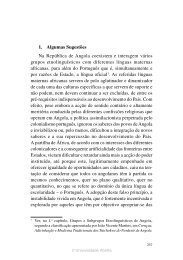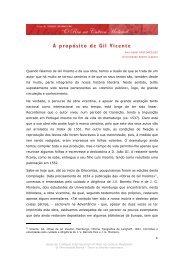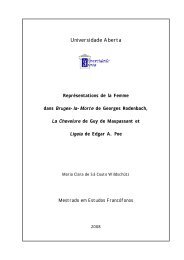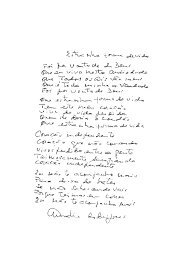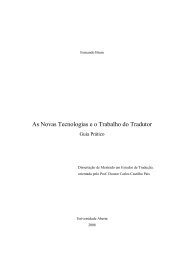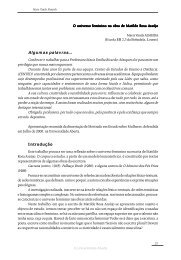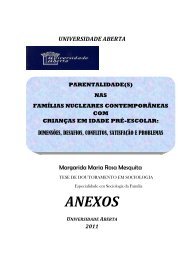Diálogos Transdisciplinares em Girl with a Pearl Earring: a Arte ...
Diálogos Transdisciplinares em Girl with a Pearl Earring: a Arte ...
Diálogos Transdisciplinares em Girl with a Pearl Earring: a Arte ...
You also want an ePaper? Increase the reach of your titles
YUMPU automatically turns print PDFs into web optimized ePapers that Google loves.
looking out the window, down to her right. She is wearing a yellow and black<br />
fitted bodice of silk and velvet, a dark blue skirt, and a white cap that hangs down<br />
in two points below her chin.’ … ‘When you look at the cap long enough’ ... ‘you<br />
see that he has not really painted it white, but blue, and violet, and yellow.’ ‘But<br />
it’s a whitecap, you said.’ ‘Yes, that’s what is so strange. It’s painted many<br />
colours, but when you look at it, you think it’s white.’ ‘Tile painting is much<br />
simpler,’ my father grumbled. ‘You use blue and that’s all. A dark blue for the<br />
outlines, a light blue for the shadows. Blue is blue.’ … I wanted him to<br />
understand that white was not simply white. It was a lesson my master had taught<br />
me. ‘What is she doing?’ ... ‘She has one hand on a pewter pitcher sitting on a<br />
table and one on a window she’s partly opened. She’s about to pick up the pitcher<br />
and dump the water from it out the window, but she’s stopped in the middle of<br />
what she’s doing and is either dreaming or looking at something in the street.’<br />
‘Which is she doing?’ ‘I don’t know. Sometimes it se<strong>em</strong>s one thing, sometimes<br />
the other.’ ... ‘First you say the ca pis white but not painted white. Then you say<br />
the girl is doing one thing or maybe another, you’re confusing me.’ … ‘I’m trying<br />
to describe it accurately.’ ‘But what is the story in the painting?’ ‘His paintings<br />
don’t tell stories’” (95-97).<br />
Além das suas tarefas habituais (lavar a roupa, dar a ferro e fazer as compras no<br />
mercado), Griet é encarregada da limpeza do ateliê de Vermeer, ao qual ninguém<br />
da casa tinha acesso, com excepção da sua poderosa sogra, a matriarca Maria<br />
Thins, que valoriza a esperteza de Griet, mas reconhece que pode causar<br />
probl<strong>em</strong>as. Utilizando-se das habilidades desenvolvidas <strong>em</strong> função da cegueira do<br />
pai, Griet limpa os móveis e objetos do estúdio, s<strong>em</strong> mudá-los de lugar. Isso gera<br />
uma situação de ainda maior conflito entre Griet e Catharina, grávida do sexto<br />
filho, e ciumenta da crescente intimidade entre seu marido e a jov<strong>em</strong> criada, que<br />
partilha um espaço onde não t<strong>em</strong> acesso, b<strong>em</strong> como a total falta de sensibilidade<br />
para com o trabalho des<strong>em</strong>penhado pelo marido:<br />
“... I asked her if I should clean the windows. ...’Why not?’ she answered<br />
sharplhy. ‘You do not need to ask me such petty things.’ ‘Because of the light,<br />
madam, ‘ I explained. ‘It might change the painting if I clean th<strong>em</strong>. You see?’<br />
She didd not see. ... Catharina went downstairs to ask him and called up me to<br />
leave the windows” (43-44).<br />
Ao des<strong>em</strong>penhar suas tarefas na limpeza do estúdio, a jov<strong>em</strong> fica cada vez mais<br />
próxima do misterioso pintor e ele devagar a introduz no mundo das seus quadros



